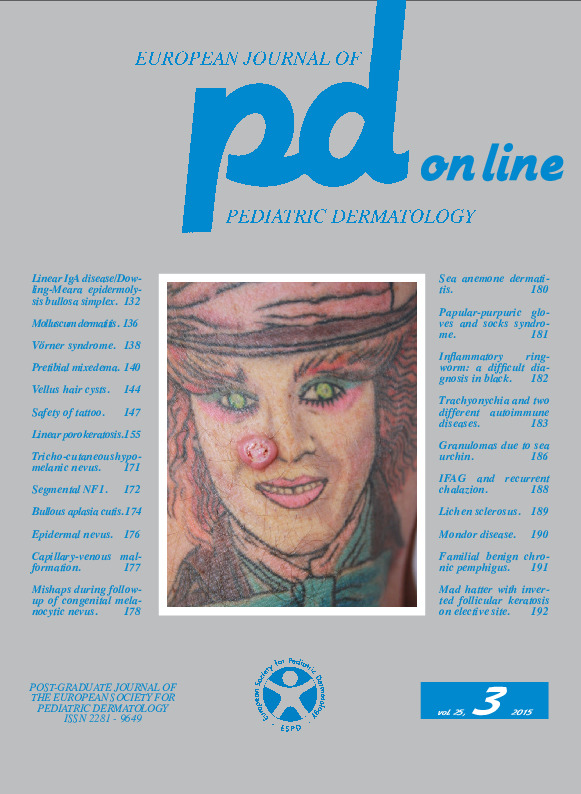Segmental neurofibromatosis 1: a 24-year follow up.
Downloads
DOI:
https://doi.org/10.26326/2281-9649.25.3.1139How to Cite
Pisani V., Bonifazi E. 2015. Segmental neurofibromatosis 1: a 24-year follow up. Eur. J. Pediat. Dermatol. 25 (3):172-73. 10.26326/2281-9649.25.3.1139.
pp. 172-173
Abstract
In generalized NF1 the various signs follow a quite accurate chronological sequence; in particular as regards café-au-lait spots and neurofibromas, the former are always present in the first years of life and then tend to regress up to be absent after 70 years, while the latter, which are exceptional in the first years of life, affect the totality of cases already in the third decade and remain for a lifetime.The different behavior of these signs is even more evident in segmental NF1 (1, 3, 4). The cases of child-hood segmental NF1 are characterized by café-au-lait spots and almost never by neurofibromas; what is more important in the cases of adult segmental NF1 neurofibromas are constant, but they are rarely associated with café-au-lait spots. One could speculate that this depends on the different natural history of the two signs. However, this could explain the lack of neurofibromas in childhood segmental NF1, but it can not account for the lack of café-au-lait spots in adult segmental NF1; in the segmental NF1 affecting adults, the cases with only neurofibromas in the absence of café au lait spots are much more numerous (4, 5); Hager et al. (1) reviewed the clinical data of 82 cases of segmental NF1, including 3 personal cases and 79 of literature, whose age of onset ranged between birth and 83 years, median 28 years: in this population all had neurofibromas, but only 22/82 (26%) had café-au-lait spots.
To explain the rarity of café au lait spots in the adult segmental NF1 some Authors (6, 7, 8) based on experimental studies, have suggested that mutations responsible for café-au-lait spots and neurofibromas affect different cells: a mutation affecting the fibroblasts would be responsible for café-au-lait spots, while a mutation affecting the Schwann cells would be responsible for neurofibromas.
Keywords
Segmental NF1, Café au lait spot, Neurofibromas

